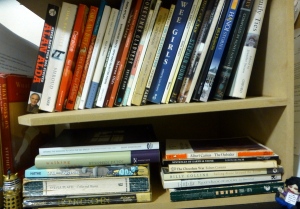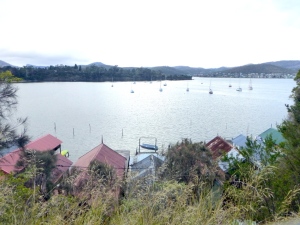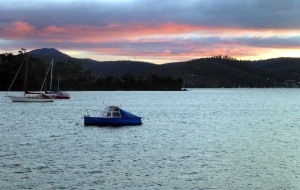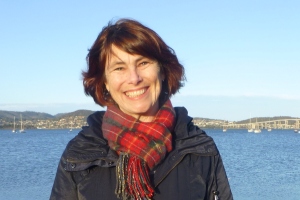Interview by Nicole Melanson ~
Jane Williams is an Australian writer based in Tasmania. She is the author of five collections of poems and one of short stories. Awards for her poetry include the FAW Anne Elder Award, the D.J. O’Hearn Memorial Fellowship and the Bruce Dawe Poetry Prize. She has read her poetry in Malaysia, UK, USA, Czech Republic, Canada and Ireland. She also writes poems and stories for children and combines photographs with short poems, inspired by the Japanese art form haiga. She edits the online journal Communion with her partner, Ralph Wessman.

HOW DID YOU GET STARTED?
Books were part of the furniture growing up. We always had a small but diverse bookcase crammed with all sorts from Shakespeare to Pam Ayres, lots of mystery novels…
Mum was a school teacher, always making up little poems and stories for her students. Dad was a natural Irish yarn spinner, often quoting Banjo Patterson and Lewis Carroll: “The time has come,” the walrus said, “to talk of many things…”
I quickly developed a love of rhythm and storytelling.
At primary school during the breaks I improvised stories in installments to a small group of kids, always leaving off at some ‘cliffhanger’.
I’ve written creatively most of my life but was in my mid-twenties before I started sending anything out. Initial rejections were crushing but they also confirmed my compulsion to write because despite them I couldn’t stop.
WHAT IS YOUR LATEST BOOK OR CURRENT PROJECT?
I’m working on a collection of poems for children and my next book of poems for adults, largely inspired by travel.
The project I’m most excited about at the moment is a three-month residency at the Bridge Guard Residential Art-Science Centre in Sturovo, Slovakia, which I’ll take up at the end of this year.
The residency encourages artists to explore moving mental, social, religious or political boundaries through bridging, connecting and uniting opposites.
WHAT IS YOUR WORK ENVIRONMENT LIKE?
Prior to travelling overseas for six months in 2014, my partner and I each had our own study. We had plenty of space and privacy. Just before our return to Australia the house was burgled, rooms trashed, including the studies… I’ve never been much of a “material girl” but that experience had a profound effect on how I saw my attachments to things, including to my work/home environment. Writing a poem addressing the “burglar boys” was cathartic and in a way helped galvanize my belief that writing is responsive and can only ultimately benefit from change.
Since then we’ve reprioritized and downsized. We now live relatively simply and frugally so that from time to time we can still explore our shared passion for travel.
When we’re home I write at my desk in a corner of our bedroom, or in bed facing the window, at the kitchen table… but really I can write anywhere. I used to think I needed “a room of one’s own” but I’m not so sure these days. More often than not my working environment is in-transit.
WHEN DO YOU WORK? WHAT DOES A TYPICAL DAY LOOK LIKE?
At home at the moment my ideal (sometimes real) working day is: awake before dawn, walk down to our local bay to watch the sunrise, back home for coffee and breakfast, work for a few hours, break for lunch with my partner, another walk together, try to get a couple more hours of work done before nightfall and that’s about it. Most days work involves a mix of daydreaming (highly underrated), note-taking, research-reading, pleasure-reading and writing. The actual writing component is buoyed by all the other components and by engaging with life outside my head. Generally I’m more of a morning person. When I wake early I’m waking into my writing life before anything else.


WHAT IS YOUR WRITING PROCESS?
Walking and note-taking are an integral part of my creative process. Also more recently, photography. And human contact. I have to remind myself how important this is—to connect with people, to be in the world and take part, not just observe and “record”.
I generally have several projects on the go so it’s a juggling act, but then I always dreamed of running away with the circus…
I like what Virginia Woolf had to say:
“The way to rock oneself back into writing is this. First gentle exercise in the air. Second the reading of good literature.”
WHY DO YOU DO WHAT YOU DO?
When I write and it’s working, I know I’m exactly where I’m meant to be doing exactly what I’m meant to do.
WHO OR WHAT INSPIRES YOU?
Pretty much anything and everything, people mostly. The extraordinary in the ordinary. Random acts of kindness, generosity. Seeing adults give in to their “inner child” now and then.

WHAT IS THE HARDEST PART OF WHAT YOU DO?
Some days the hardest thing is believing in the value of what I’m doing…thinking maybe I should be doing something more evidenced, more worthwhile like planting trees or producing something useful. Like traffic lights. Seriously.
When I find myself doubting the value of writing, I turn to the work of other writers. I read until I forget I’m a writer, then I allow myself to remember, Oh yeah, this is what I do! Then for better or worse I’m back on track.
Writing isn’t about instant gratification. It’s a life’s work. And play—don’t forget to play.
WHAT DO YOU WISH YOU HAD KNOWN WHEN YOU STARTED?
I believe we can only really know what we experience, so development as a writer, as a human being needs to be fraught at times as well as blessed. It’s all part of the journey.
WHAT IS YOUR ARTISTIC OR PROFESSIONAL VISION?
To continue exploring and sharing life’s journey through creative expression.
To give pleasure through my writing for children. I can’t imagine my childhood without the adventure of reading; the idea of giving something of that back is deeply satisfying.
WHO ARE YOUR FAVORITE FEMALE AUTHORS?
Books I’ve loved by female authors are many and varied. As a child I devoured all of Enid Blyton’s then moved on to Agatha Christie. Harper Lee’s To Kill a Mocking Bird and Emily Bronte’s Wuthering Heights were favorites as I got older. Jane Austen, Emily Dickinson, Virginia Woolf, Sylvia Plath, Isabelle Allende, Amy Tan, Margaret Attwood, Alice Munro…
Two books I respected greatly for their candor were the 1999 novel Gaining Ground by Joan Barfoot and the 2001 memoir A Life’s Work: On becoming a Mother by Rachel Cusk.
WHICH FEMALE AUTHOR WOULD YOU LIKE TO SEE INTERVIEWED ON WORDMOTHERS NEXT?
Kate Llewellyn, the first Australian female poet I identified with.
Thank you, Jane Williams!
— Nicole Melanson
* Author photo by Ralph Wessman
Like this interview? Follow WordMothers or Subscribe to meet more great female authors!


Jane Williams sounds a beautiful talented woman with her feet on the ground and her head in the clouds- long may she be inspired to write and share her writings with us all! X
LikeLiked by 1 person